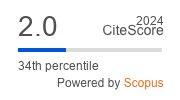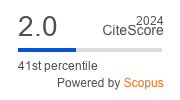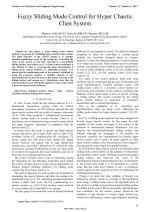| 1/2012 - 14 |
Fuzzy Sliding Mode Control for Hyper Chaotic Chen SystemSARAILOO, M. |
| Extra paper information in |
| Click to see author's profile in |
| Download PDF |
Author keywords
nonlinear systems, chaos, fuzzy control, Lyapunov method, sliding mode control
References keywords
chaos(29), control(16), chaotic(16), solitons(14), fractals(14), systems(12), jchaos(12), sliding(10), mode(10), synchronization(9)
Blue keywords are present in both the references section and the paper title.
About this article
Date of Publication: 2012-02-28
Volume 12, Issue 1, Year 2012, On page(s): 85 - 90
ISSN: 1582-7445, e-ISSN: 1844-7600
Digital Object Identifier: 10.4316/AECE.2012.01014
Web of Science Accession Number: 000301075000014
SCOPUS ID: 84860754665
Abstract
In this paper, a fuzzy sliding mode control method is proposed for stabilizing hyper chaotic Chen system. The main objective of the control scheme is to stabilize unstable equilibrium point of the system by controlling the states of the system so that they converge to a pre-defined sliding surface and remain on it. A fuzzy control technique is also utilized in order to overcome the main disadvantage of sliding mode control methods, i.e. chattering problem. It is shown that the equilibrium point of the system is stabilized by using the proposed method. A stability analysis is also performed to prove that the states of the system converge to the sliding surface and remain on it. Simulations show that the control method can be effectively applied to Chen system when it performs hyper chaotic behavior. |
| References | | | Cited By «-- Click to see who has cited this paper |
| [1] O. E. Rossler, "An equation for hyper chaos," Physics Letters A, Vol. 71, pp. 155-157, 1979, [CrossRef] [SCOPUS Times Cited 1326] [2] G. Qi, G. Chen, S. Du, Z. Chen, and Z. Yuan, "Analysis of a new chaotic system," Physica A: Statistical Mechanics and its Applications, vol. 352, pp. 295-308, 2005, [CrossRef] [SCOPUS Times Cited 301] [3] J. P. Goedgebuer, L. larger, and H. Porle, "Optical cryptosystem based on synchronization of hyper chaos generated by a delayed feedback tunable laser diode," Physical Review Letters, vol. 80, pp. 2249-2252, 1998, [CrossRef] [SCOPUS Times Cited 453] [4] Y. O. Ushenko, Y. Y. Tomka, I. Z. Misevich, A. P. Angelsky, and V. T. Bachinsky, "Polarization-singular Processing of Phase-inhomogeneous Layers Laser Images to Diagnose and Classify their Optical Properties," Advances in Electrical and Computer Engineering, vol. 11, pp. 3-10, 2011, [CrossRef] [Full Text] [SCOPUS Times Cited 2] [5] S. Cincotti, and SD. Stefano, "Complex dynamical behaviors in two non-linearly coupled chua's circuits," Chaos, Solitons and Fractals, vol. 21, pp. 633-641, 2004, [CrossRef] [SCOPUS Times Cited 21] [6] C. Li, X. Liao, and K. Wang, "Lag synchronization of hyper chaos with application to secure communication," Chaos, Solitons and Fractals, vol. 23, pp. 183-193, 2005, [CrossRef] [SCOPUS Times Cited 203] [7] A. Genys, A. Tamasevicius, and A. Bazailiauskas, "Hyper chaos in coupled colpitts oscillators," Chaos, Solitons and Fractals, vol. 17, pp. 349-353, 2003, [CrossRef] [SCOPUS Times Cited 139] [8] H. Radmanesh, and M. Rostami, "Effect of Circuit Breaker Shunt Resistance on Chaotic Ferroresonance in Voltage Transformer," Advances in Electrical and Computer Engineering, vol. 10, pp. 71-77, 2010, [CrossRef] [Full Text] [SCOPUS Times Cited 27] [9] C. Morel, D. Petreus, and A. Rusu, "Application of the Filippov Method for the Stability Analysis of a Photovoltaic System," Advances in Electrical and Computer Engineering, vol. 11, pp. 93-98, 2011, [CrossRef] [Full Text] [SCOPUS Times Cited 12] [10] Z. Chen, Y. Yuang, G. Qi, and Z. Yuan, "A novel hyper chaos system only with one equilibrium," Physics Letters A, vol. 36, pp. 696-701, 2007, [CrossRef] [SCOPUS Times Cited 133] [11] H. T. Yau, and C. L. Chen, "Chattering-free fuzzy sliding-mode control strategy for uncertain chaotic systems," Chaos, Solitons and Fractals, vol. 30, pp. 709-718, 2006, [CrossRef] [SCOPUS Times Cited 122] [12] T. Y. Chiang, M. L. Hung, J. J. Yan, Y. S. Yang, and J. F. Chang, "Sliding mode control for uncertain unified chaotic systems with input nonlinearity," Chaos, Solitons and Fractals, vol. 34, pp. 437-442, 2007, [CrossRef] [SCOPUS Times Cited 57] [13] K. Pyragas, "Continuous control of chaos by self-controlling feedback," Physics Letters A, vol. 170, pp. 421-428, 1992, [CrossRef] [SCOPUS Times Cited 3208] [14] D. Chen, J. Sun, and C. Huang, "Impulsive control and synchronization of general chaotic system," Chaos, Solitons and Fractals, vol. 14, pp. 627-632, 2002, [CrossRef] [SCOPUS Times Cited 71] [15] F. Q. Dou, J. A. Sun, W. S. Duan, and K. P. Lü, "Controlling hyperchaos in the new hyper chaotic system," Communications in Nonlinear Science and Numerical Simulation, vol. 14, pp. 552-559, 2009, [CrossRef] [SCOPUS Times Cited 43] [16] C. Piccardi, and L. L. Ghezzi, "Optimal control of chaotic map: Fixed point stabilization and attractor confinement," International Journal of Bifurcation and Chaos, vol. 7, pp. 437-446, 1997, [CrossRef] [SCOPUS Times Cited 29] [17] M. Feki, "Sliding mode control and synchronization of chaotic systems with parametric uncertainties," Chaos, Solitons and Fractals, vol. 41, pp. 1390-1400, 2009, [CrossRef] [SCOPUS Times Cited 70] [18] E. Ott, C. Grebogi, and J. A. Yorke, "Controlling chaos," Physical Review Letters, vol. 64, pp. 1196-1199, 1990, [CrossRef] [SCOPUS Times Cited 6088] [19] H. Layeghi, M. Tabe Arjmand, H. Salarieh, and A. Alasty, "Stabilizing periodic orbits of chaotic systems using fuzzy adaptive sliding mode control," Chaos, Solitons and Fractals, vol. 37, pp. 1125-1135, 2008, [CrossRef] [SCOPUS Times Cited 59] [20] H. T. Yau, "Chaos synchronization of two uncertain chaotic nonlinear gyros using fuzzy sliding mode control," Mechanical Systems and Signal Processing, 2008, vol. 22, pp. 408-418, [CrossRef] [SCOPUS Times Cited 133] [21] B. Wang and G. Wen, "On the synchronization of a class of chaotic systems based on backstepping method, " Physics Letters A, vol. 370, pp. 35-39, 2007, [CrossRef] [SCOPUS Times Cited 37] [22] H. T. Yau, and J. J. Yan, "Chaos synchronization of different chaotic systems subjected to input nonlinearity," Applied Mathematics and Computation, vol. 197, pp. 775-788, 2008, [CrossRef] [SCOPUS Times Cited 88] [23] M. T. Yassen, "Controlling chaos and synchronization for new chaotic system using linear feedback control," Chaos, Solitons and Fractals, vol. 26, pp. 913-920, 2005, [CrossRef] [SCOPUS Times Cited 179] [24] D. I. R. Almeida, J. Alvarez, and J. G. Barajas, "Robust synchronization of Sprott circuits using sliding mode control," Chaos, Solitons and Fractals, vol. 30, pp. 11-18, 2006, [CrossRef] [SCOPUS Times Cited 62] [25] J. F. Chang, M. L. Hung, Y. S. Yang, T. L. Liao, and J. J. Yan, "Controlling chaos of the family of Rossler systems using sliding mode control," Chaos, Solitons and Fractals, vol. 37, pp. 609-622, 2008, [CrossRef] [SCOPUS Times Cited 51] [26] S. Dadras, H. R. Momeni, and V. J. Majd, "Sliding mode control for uncertain new chaotic dynamical system," Chaos, Solitons and Fractals, vol. 41, pp. 1857-1862, 2009, [CrossRef] [SCOPUS Times Cited 62] [27] M. J. Jang, C. L. Chen, and C. K. Chen, "Sliding mode control of hyper chaos in Rossler systems," Chaos, Solitons and Fractals, vol. 14, pp. 1465-1476, 2002, [CrossRef] [SCOPUS Times Cited 67] [28] J. J. Yan, "H infinity controlling hyper chaos of the Rossler system with input nonlinearity," Chaos, Solitons and Fractals, vol. 21, pp. 283-293, 2004, [CrossRef] [SCOPUS Times Cited 22] [29] Y. C. Hung, T. L. Liao, and J. J. Yan, "Adaptive variable structure control for chaos suppression of unified chaotic systems," Applied Mathematics and Computation, vol. 209, pp. 391-398, 2009, [CrossRef] [SCOPUS Times Cited 27] [30] M. Roopaei, B. R. Sahraei and T. C. Lin, "Adaptive sliding mode control in a novel class of chaotic systems," Communications in nonlinear science and numerical simulation, vol. 15, pp. 4158-4170, 2010, [CrossRef] [SCOPUS Times Cited 111] [31] J. J. E. Slotine, and W. P. Li, Applied Nonlinear Control, Englewood Cliffs: Prentice-Hall, 1991. [32] H. K. Khalil, Nonlinear Systems, 3rd ed., Englewood Cliffs: Prentice-Hall, 2002. Web of Science® Citations for all references: 0 SCOPUS® Citations for all references: 13,203 TCR Web of Science® Average Citations per reference: 0 SCOPUS® Average Citations per reference: 413 ACR TCR = Total Citations for References / ACR = Average Citations per Reference We introduced in 2010 - for the first time in scientific publishing, the term "References Weight", as a quantitative indication of the quality ... Read more Citations for references updated on 2025-07-02 08:16 in 199 seconds. Note1: Web of Science® is a registered trademark of Clarivate Analytics. Note2: SCOPUS® is a registered trademark of Elsevier B.V. Disclaimer: All queries to the respective databases were made by using the DOI record of every reference (where available). Due to technical problems beyond our control, the information is not always accurate. Please use the CrossRef link to visit the respective publisher site. |
Faculty of Electrical Engineering and Computer Science
Stefan cel Mare University of Suceava, Romania
All rights reserved: Advances in Electrical and Computer Engineering is a registered trademark of the Stefan cel Mare University of Suceava. No part of this publication may be reproduced, stored in a retrieval system, photocopied, recorded or archived, without the written permission from the Editor. When authors submit their papers for publication, they agree that the copyright for their article be transferred to the Faculty of Electrical Engineering and Computer Science, Stefan cel Mare University of Suceava, Romania, if and only if the articles are accepted for publication. The copyright covers the exclusive rights to reproduce and distribute the article, including reprints and translations.
Permission for other use: The copyright owner's consent does not extend to copying for general distribution, for promotion, for creating new works, or for resale. Specific written permission must be obtained from the Editor for such copying. Direct linking to files hosted on this website is strictly prohibited.
Disclaimer: Whilst every effort is made by the publishers and editorial board to see that no inaccurate or misleading data, opinions or statements appear in this journal, they wish to make it clear that all information and opinions formulated in the articles, as well as linguistic accuracy, are the sole responsibility of the author.



